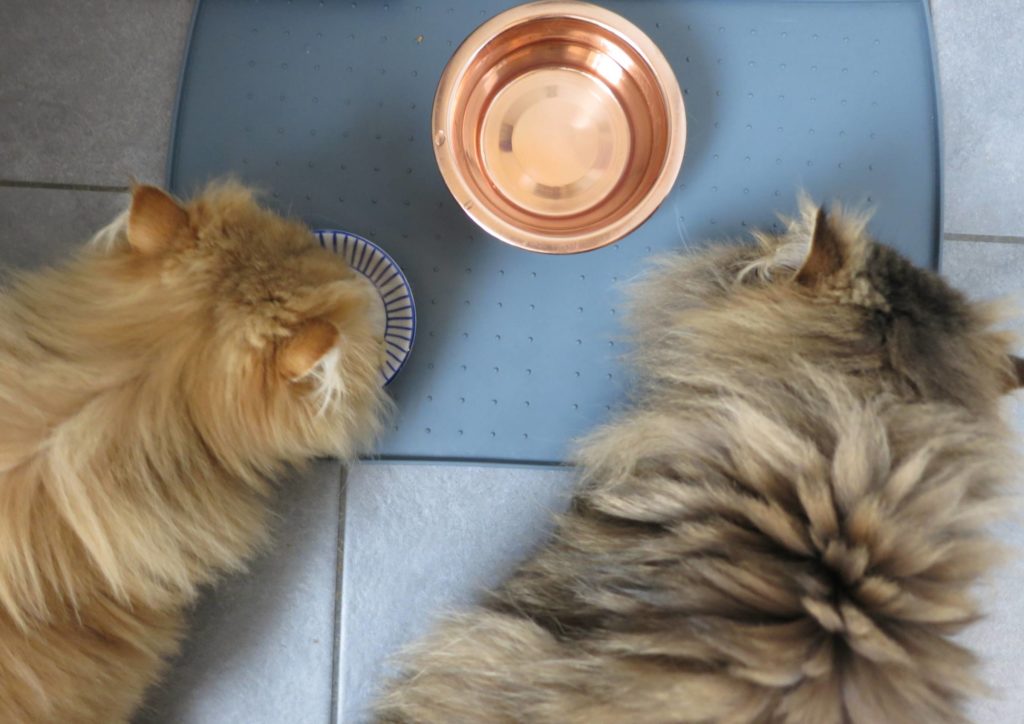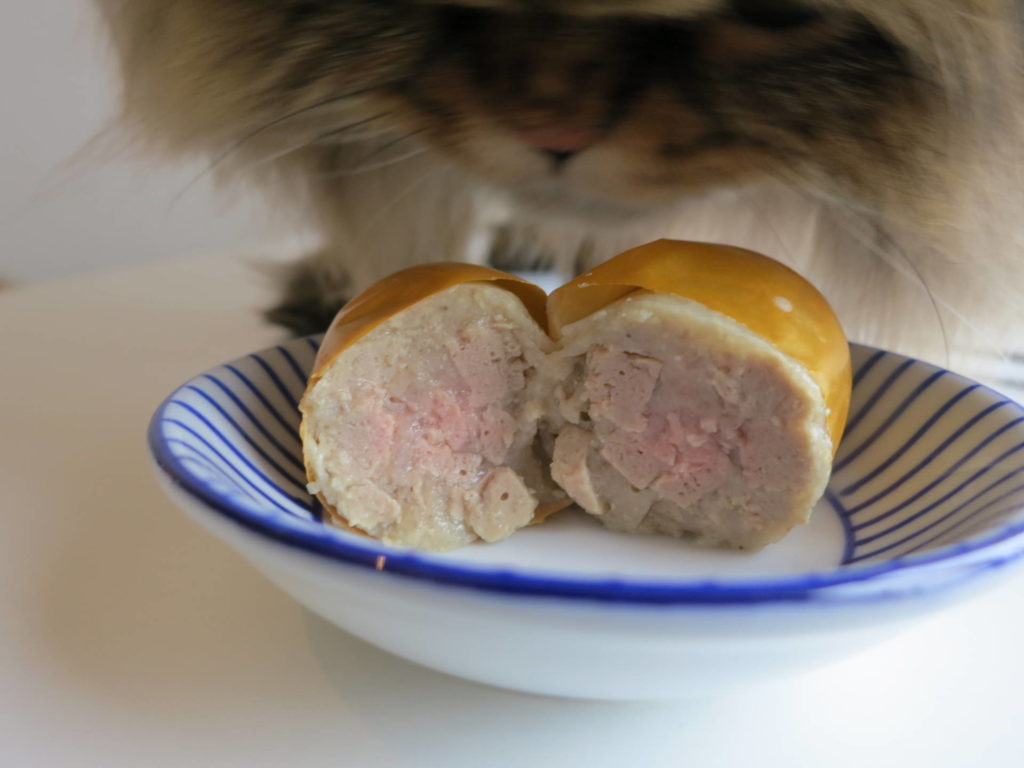Dealing with a cat that has food allergies can be a nightmare. Vomiting, diarrhea, skin issues, refusal to eat, expensive diets, it can be incredibly frustrating for you and painful for your cat. But there are ways to prevent food allergies.
First there are 2 different types of allergies: environmental and food. Environmental allergies could be pollen, grass, other animals, cotton, mold, etc. These can be caused by indoors or outdoor factors and can be seasonal. Food allergies are a result of the food consumed.
What is the difference between food allergy and food intolerance?
Food allergy symptoms can include skin problems, hair loss, excessive itching or over-grooming. Much more common is a food intolerance which usually results in vomiting or diarrhea after eating certain foods.

What causes food allergies or intolerance?
There is not one clear answer to why cats develop allergies. There are some foods that are more likely to cause allergies such as seafood, wheat, corn and soy, dairy and wheat glutton. An allergy or intolerance to a particular ingredient or protein source is often caused by the cat being over exposed over a long period of time to that food source.
How can you prevent food allergies/intolerance?
It’s a huge myth that you shouldn’t change your cat’s diet. Pet food companies want you to believe that you shouldn’t change your cat’s food because they want a loyal lifelong customer. Cats benefit greatly from a diet full of variety and different protein sources. By feeding a variety of high quality foods you are strengthening your cat’s GI track and lowering their risk of becoming intolerant or allergic. Cats in the wild would eat a variety of small animals and birds and would not eat the same thing every day.
Another reason to feed a variety of foods is to prevent Cat Food Boredom. Cat’s have addictive and stubborn personalities. By only feeding one food for too long the cat can either become addicted to the food and refuse to eat anything else or inversely they may become bored with their food and refuse to eat it.
I feed a homemade raw diet mostly consisting of chicken, turkey and beef. Therefore when I buy commercial can food I try to buy protein sources that I do not make at home such as rabbit, lamb and duck. My cats are so accustom to a varied diet that I can feed them 7 days in a row of 7 different foods (homemade raw chicken, homemade raw beef, commercial raw and different high quality canned foods of different protein sources) and there is no difference in their stool and adapt to the change just fine.
I often people hear people asking or searching for the single best cat food. The answer is that there is not just one perfect food. You should be looking to find a variety of foods that are of high quality.
If your cat is young you can start varying their diet now. If your cat is older and has not been exposed to variety then the transition to start new foods should be slow.
Just like humans, if for years you only ate potatoes and then one day you eat Chinese food, you will likely have an upset stomach. But if you continuously eat a variety of foods your GI system will be able to handle all foods.
I do not recommend feeding any dry food. Dry food does not contain enough moisture and contains too many filler ingredients such as corn, wheat and soy that cats do not need and are not designed to eat. Instead high quality wet food and a complete balanced commercial or homemade raw diet. Dry food should not be mixed with raw food see my post on mixing raw with wet and dry food.
How to treat cats with a food allergy or intolerance is a whole other issue. If you do not have these issues please do what you can now to vary your cat’s food so you don’t have to deal with food allergies in the future.


Awww crap, I didn’t realise I already commented on this! The above comment meant to be posted on a different post, argh, sorry! ;)
My boy Spider had a similar reaction last year when I was feeding him Royal Canin’s Senior Consult 2. I only noticed when he had already lost a lot of fur around his neck that he had been scratching there more than usual, and all his fur got really thin because of this, almost down to the skin. Within 2 weeks of switching him to raw, he stopped scratching and a couple of months later all his fur had grown back. He did not have problems with veterinary diets before, but he is now almost 18 years old and more sensitive to a lot of things (antibiotics and anti-inflammatories too, he got quite sick on those recently, with blood in his stool and bloody vomit!).
This is great info. I jumped over to your post about “mixing raw with wet and dry food”, but comments are closed on that, so I am going to comment here.
For the last 1 1/2 years, I have fed my 3 cats only raw, but my 17 1/2 year old boy Spider has had kidney disease for the last two years, and his last blood test was measurably worse than before and my vet suggested to feed a veterinary kidney diet (Hills and RC). Spider really doesn’t like any of the different flavours, so she said that I should mix just a spoon of wet into the raw food. She also recommended the special renal diet dry food, to which I said “well, that can’t be good because it’s dry, and with his kidney failure he really needs *more* moisture and not less!”. But she said that this food is specifically formulated *for* cats with kidney disease, and when I got a small trial bag home, I did see that these little pellets are actually very moist, more so than other “kibble”. Still… I am skeptical about this, of course!
What do you think about it?
Author
I am a disbeliever when it comes to prescription diets. I’ve heard from many others that raw food has helped when the prescription foods have not. Unfortunately vets are recommending these because it is all they have been taught to do to treat disease. I believe that the raw you are feeding is the best thing for them. That said, you have done extremely well to raise a 17.5 year old cat. I think at that age I think its most important that he is eating, maintaining a healthy weight and is comfortable. While his condition is unlikely to improve drastically, I don’t believe feeding him a dry kibble will improve his condition.
I myself am also a disbeliever in prescription diets. My personal conspiracy theory is that they are designed to make our cats ill so that vets can make more money, and of course, the cat food companies too.
At the same time, looking back, I don’t think Lugosi (Spider’s brother) would still be alive if I had not put him on a urinary prescription diet 12 years ago after he had serious problems with FLUTD and had a perineal urethrostomy done, but that was before I ever knew about feeding raw, mind you.
One other thought I had though, is that the high protein content in raw food is not particularly good for kidney diseased cats. I already give Spider a supplement to help with this (Renafood, one tablet a day), and mix pumpkin into the raw food. But his renal values are still bad, and the only reason why I agreed with the vets this time is because it’s worth a try for a couple of months and then do another renal panel to see if it helps. However, like you say, at his age, it is more important that he eats at all and he’s comfortable, and he has put on a bit of weight again after losing some (for whatever reason) last year. :)
We eat both raw and high quality canned food, just like you, and Claire tries to vary protein sources as well. Purrs
Author
Excellent, your cats are so well taken care of :-)
One of my cats started chewing out his arms’ fur. It was bad, he was only a year old and only eating vet kibbled food.
The vet wanted me to switch my cat to a hypoallergenic kibble food ( and my other young cat to a low calorie diet) I told her about raw and that it might solve both my cats’ problems… she didn’t want me to. I did it.
One month later, he stopped chewing him arm and it grew back and my other cat is gradually loosing weight.
Thank you for this post, it’s so true and more people need to know about this. That cat’s bodies aren’t ment to digest cooked process highly transformed chicken (as well as all the other crap in kibbled food) or even denaturalyzed chicken (meat used in hypoallergenic food).
Author
I’m so happy your cats are doing well. Congratulations on going raw and improving your cats’ lives. I know its not easy to go against what a vet says. I really hope vet schools start to focus on pet nutrition. It is such a vital part of our pets’ health. I’m curious what kind of raw do you feed? Thanks for commenting!
I know, I’m so happy that I made the switch.
I also hope that vets will be more open and learn about raw food. But I saw a second vet, at the same clinic, for the yearly vaccination and she makes her own cooked cat food! She also didn’t think going raw was a good idea… but it was still very hopeful.
I mostly feed them chicken, they eat beef pretty often (I use your recipe :D )
I saw that you feed your kitties turkey, do you use turkey bones? I tried once and the bones were so hard to crush. Do you have any tricks, like the chicken necks for the beef?
Author
When I use turkey I only add in some turkey breast, for example if I have too much bone and need more muscle meat in the mix. I have never tried grinding turkey bone as I imagine it would be quite tough. I still have my original manual grinder that I’ve been using for over two years now. I keep meaning to upgrade but it still works so I can’t push myself to buy a new one just yet.
Very interesting, I always thought it was bad to change foods.
The mom feeds us a variety of foods…mainly so we don’t get bored with one.
Author
Lucky cats, yes variety is key!